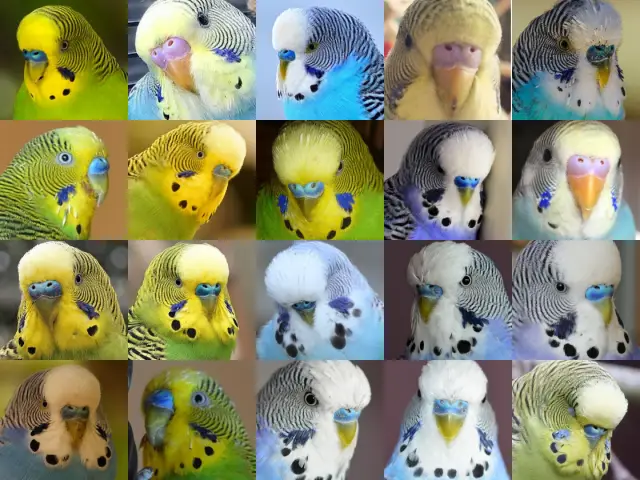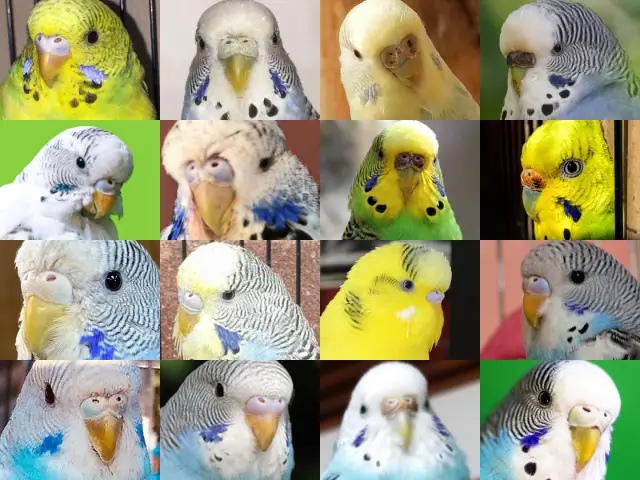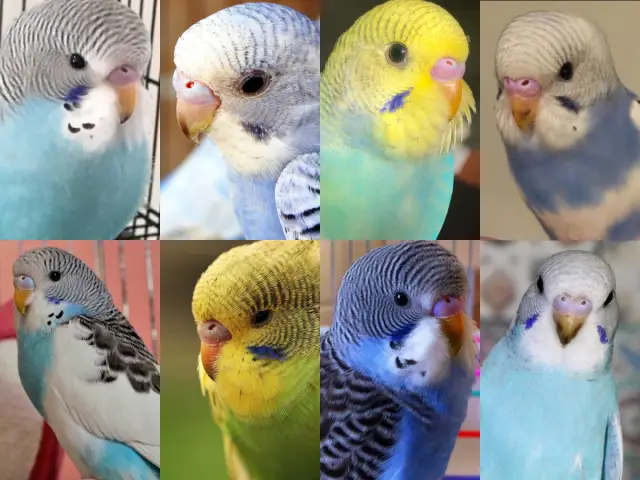No, budgies cannot change their gender.
Their sex is determined by the ZW sex-determination system, where males are ZZ and females are ZW.
However, changes in cere color due to hormonal fluctuations, misunderstanding of the budgie’s sex from the very beginning or diseases like testicular tumors, liver disiase and infections can often lead to misunderstandings about a budgie’s gender.
As a former a budgie enthusiast, I’ve encountered a range of questions about these feathered companions.
One of the most intriguing is: Can budgies change gender? As strange as it might sound, this question arises from the curious phenomena observed in a budgie’s cere – that fleshy, waxy structure located just above their beak.
Its color seems to shift over time, and for some, it signals a change in gender.
I remember scratching my head over the same conundrum with my first budgie.
However, the reality is much more complicated and involves hormones, diseases, and illnesses.
Let’s explore this captivating topic together.
How Is The Sex Of The Offspring Determined Biologically In Animals Such As Budgies?
In avian species, including budgies, the process of sex determination is an intriguing dance of chromosomes, a journey that begins long before these charming birds take their first fluttering flight.
Unlike us humans, where males have XY chromosomes and females have XX, birds operate a little differently on the genetic level.
Budgies, like other avian species, use a system referred to as ZW sex-determination.
In this ZW system, males are ZZ (homogametic) and females are ZW (heterogametic).
It’s quite the role reversal from what we see in mammalian species! This means that in budgies, and indeed in most avian species, it is the female that determines the sex of the offspring, not the male.
A female budgie can pass on either a Z or a W chromosome, while a male only passes on a Z chromosome.
Eggs that receive the Z chromosome from the mother will develop into males (ZZ), while those that receive the W chromosome will develop into females (ZW).
So when you watch a female budgie tending her eggs, consider the amazing process she has initiated: with each egg she lays, she is actually determining the sex of her future chicks.
So, “Can Budgies Change Gender?” Why Is The Question Asked?
The question of budgies changing gender typically arises due to observable changes in a budgie’s physical characteristics and behavior over time.
Chiefly, these changes revolve around the cere – that fleshy, waxy structure just above their beak.
At different times, the color of a budgie’s cere can shift, leading many budgie owners to question whether a gender change has occurred.
It’s important to understand that these changes, although seemingly dramatic, are a part of the budgie’s natural lifecycle and can be influenced by factors such as hormonal fluctuations, seasonal changes, and health issues, like testicular tumors, liver disiase and infections.
These can manifest in a shift in cere color, leading to the presumption of a gender change.
However, no actual ‘gender swap’ is happening here.
You May Have Misunderstood Your Budgie’s Sex From The Very Beginning! (This Situation Is Very Common)
When baby budgies come into the world, they’re not wearing convenient gender badges.
Rather, the task of determining their sex can be exceptionally tricky.
Budgie hatchlings, or fledglings, have non-specific cere colors, usually appearing purplish-blue or pinkish-brown regardless of their sex, making it an unreliable indicator of their gender.
In my own experience, and from countless accounts from other budgie owners and breeders, it’s clear that the gender prediction of baby budgies is often muddled.
It’s quite common for new owners to receive a budgie thought to be male, only to watch in confusion as it grows and its cere color changes, indicating it’s actually a female! This common occurrence is one of the primary reasons why the question, “Can budgies change gender?” crops up so often.
But, remember, it’s not a matter of the budgie changing gender, but rather a matter of us humans better understanding these delightful avian companions.
The Fact That The Budgerigar Cere Changes Color According To Hormones And Diseases Confuses People
A budgie’s cere color can seem like a fascinating riddle.
This waxy area above their beak can shift shades due to a multitude of factors, including hormonal changes and health issues.
Observing these shifts, it’s easy to understand why some might think their budgie is changing gender.
But rest assured, these shifts in coloration do not indicate a gender change.
They’re simply markers of different stages in a budgie’s life or signals of possible health concerns.
Cere Color May Change Depending On Hormones
Just like our bodies, budgies also experience hormonal fluctuations.
These hormonal changes can significantly impact a budgie’s cere color.
For instance, when a male budgie reaches sexual maturity, its cere often takes on a more vibrant blue shade.
On the other hand, a female budgie’s cere may transform into a brown or tan color, particularly when she’s in breeding condition.
These color shifts are normal and are part of a budgie’s sexual maturation process.
Hormonal Changes In Budgies Can Also Affect Behavior And Confuse People
Further deepening the confusion, hormonal changes in budgies don’t just impact their physical appearance; they also influence their behavior.
A budgie brimming with hormones might exhibit shifts in behavior, including increased aggression or a greater inclination for mating behaviors.
As their behavior changes, owners can sometimes misinterpret these signs, leading to the mistaken belief that a gender change is underway.
But remember, these are simply behavioral shifts linked to hormonal changes and are not indicators of a budgie changing gender.
Cere Color May Change Depending On Diseases, Sickness
The cere color of budgies isn’t merely an indicator of their hormonal changes or sexual maturity.
In many instances, it can act as an indicator of underlying health issues, giving owners a crucial clue about their pet’s wellbeing.
Let’s discuss a few health conditions that can bring about noticeable changes in a budgie’s cere color.
Testicular tumors, for instance, can have a significant impact on a budgie’s cere color.
This color change might lead owners to believe that a gender change has occurred.
However, it’s important to remember that this is a result of the health issue, not a shift in gender.
In addition to tumors, liver disease can also affect a budgie’s cere color.
The liver plays a crucial role in metabolizing hormones in birds, just as it does in humans.
Therefore, a liver disease can disrupt hormonal balance, leading to changes in cere color.
These shifts can be confusing, potentially leading to misconceptions about the budgie’s gender.
Lastly, infections, specifically fungal or bacterial infections, can cause changes in cere color too.
These infections often lead to inflammation, which can cause the cere to appear reddened or darkened.
This shift, though concerning, is not indicative of a gender change but signals an urgent need for veterinary attention.
As a budgie owner, it’s essential to keep an eye on any changes in your pet’s cere color.
While it could be a normal hormonal shift, it might also be a sign of a more serious health condition requiring immediate medical intervention.
What Are The Cere Colors Of Healthy Male And Female Budgies?
For those who share their lives with budgies, understanding the nuances of their cere colors can be a gateway to a deeper understanding of these remarkable creatures.
Recognizing the typical cere colors of healthy male, female, and baby budgies can not only aid in accurate gender identification but also act as an early warning system for potential health issues.
Male Budgie Cere Color
In a healthy, mature male budgie, the cere typically exhibits a vibrant, royal blue color.
It’s a bright and eye-catching hue, signaling that the budgie is sexually mature and ready to breed.
However, it’s worth noting that in some budgie varieties, such as the recessive pieds and lutinos, males retain a youthful, pinkish-purplish cere color throughout their lives.

Female Budgie Cere Color
The cere color of a healthy, adult female budgie is a bit more complex.
When she’s not in breeding condition, her cere generally presents a smooth, chalky white or bluish-white color.
However, when a female budgie is ready to breed, her cere transforms into a dark tan or brownish color, often with a rough, crusty texture.
This change is entirely normal and a part of the natural breeding process.

Baby Budgie Cere Color
The cere of a baby budgie, irrespective of its gender, often creates a charming puzzle for bird enthusiasts.
The young ones typically sport a purplish-blue or pinkish-brown cere, making it challenging to accurately determine their gender.
As they grow and reach sexual maturity, their cere color will shift according to their gender, shedding clarity on their initial gender mystery.

FAQs
Why Do Baby Budgies Have A Non-Specific Cere Color?
Baby budgies have non-specific cere colors, usually purplish-blue or pinkish-brown, making it hard to determine their gender at a young age.
This color ambiguity is because they have yet to reach sexual maturity, where hormonal changes will trigger a shift in cere color according to their specific gender.
How Can I Correctly Determine The Gender Of My Budgie?
Determining the gender of your budgie relies heavily on the cere color, but it’s not always foolproof due to factors like age, hormonal fluctuations, and health conditions.
Generally, mature males have a blue cere, while mature females have a brown or white cere, and baby budgies have a purplish-blue or pinkish-brown cere.
For a more accurate determination, consult with an avian vet.



